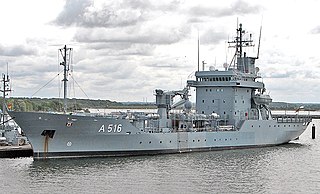
A cruiser is a type of warship. Modern cruisers are generally the largest ships in a fleet after aircraft carriers and amphibious assault ships, and can usually perform several operational roles from search-and-destroy to ocean escort to sea denial.

A carrier battle group (CVBG) is a naval fleet consisting of an aircraft carrier capital ship and its large number of escorts, together defining the group. The CV in CVBG is the United States Navy hull classification code for an aircraft carrier.
The United States Navy, United States Coast Guard, and United States National Oceanic and Atmospheric Administration (NOAA) use a hull classification symbol to identify their ships by type and by individual ship within a type. The system is analogous to the pennant number system that the Royal Navy and other European and Commonwealth navies use.

The Kriegsmarine was the navy of Nazi Germany from 1935 to 1945. It superseded the Imperial German Navy of the German Empire (1871–1918) and the inter-war Reichsmarine (1919–1935) of the Weimar Republic. The Kriegsmarine was one of three official branches, along with the Heer and the Luftwaffe, of the Wehrmacht, the German armed forces from 1935 to 1945.

A warship or combatant ship is a ship that is used for naval warfare. Usually they belong to the navy branch of the armed forces of a nation, though they have also been operated by individuals, cooperatives and corporations. As well as being armed, warships are designed to withstand damage and are typically faster and more maneuverable than merchant ships. Unlike a merchant ship, which carries cargo, a warship typically carries only weapons, ammunition and supplies for its crew.

A ship's tender, usually referred to as a tender, is a boat or ship used to service or support other boats or ships. This is generally done by transporting people or supplies to and from shore or another ship.
The names of commissioned ships of the United States Navy all start with USS, for United States Ship. Non-commissioned, primarily civilian-crewed vessels of the U.S. Navy under the Military Sealift Command have names that begin with USNS, standing for United States Naval Ship. A letter-based hull classification symbol is used to designate a vessel's type. The names of ships are selected by the Secretary of the Navy. The names are those of states, cities, towns, important persons, important locations, famous battles, fish, and ideals. Usually, different types of ships have names originated from different types of sources.
Surface combatants are a subset of naval warships which are designed for warfare on the surface of the water, with their own weapons and armed forces. They are generally ships built to fight other ships, submarines, aircraft or land targets, and can carry out several other missions including counter-narcotics operations and maritime interdiction. Their primary purpose is to engage space, air, surface, and submerged targets with weapons deployed from the ship itself, rather than by crewed carried craft.

An auxiliary ship is a naval ship designed to support combatant ships and other naval operations. Auxiliary ships are not primary combatant vessels, though they may have some limited combat capacity, usually for purposes of self-defense.
The Royal Australian Navy, although a significant force in the Asia-Pacific region, is nonetheless classed as a medium-sized navy. Its fleet is based around two main types of surface combatant, with limited global deployment and air power capability. However, in 2009, a white paper, Defending Australia in the Asia Pacific Century: Force 2030, was produced by the Australian government which set out a programme of defence spending that will see significant improvements to the RAN's fleet and capabilities. In recent times, Australia released its Surface Fleet Review in 2024, which analyses the future of the RAN and shows what the Government will procure.

A destroyer tender or destroyer depot ship is a type of depot ship: an auxiliary ship designed to provide maintenance support to a flotilla of destroyers or other small warships. The use of this class has faded from its peak in the first half of the 20th century as the roles and weaponry of small combatants have evolved.

A green-water navy is a maritime force that is capable of operating in its state's littoral zones and has limited competency to operate in the surrounding marginal seas. It is a relatively new term, and has been created to better distinguish, and add nuance, between two long-standing descriptors: blue-water navy and brown-water navy.

The People's Liberation Army Navy Surface Force is the surface warfare branch of China's People's Liberation Army Navy (PLAN), consisting of all surface vessels in operational service with the PLAN. The PLAN Surface Force operates 661 ships organized into three fleets: the North Sea Fleet, the East Sea Fleet and the South Sea Fleet.

The 3-inch/50-caliber gun in United States naval gun terminology indicates the gun fired a projectile 3 inches (76 mm) in diameter, and the barrel was 50 calibers long. Different guns of this caliber were used by the U.S. Navy and U.S. Coast Guard from 1900 through to 1990 on a variety of combatant and transport ship classes.
This glossary defines the various types of ships and accessory watercraft that have been used in service of the United States. Such service is mainly defined as military vessels used in the United States Navy and United States Coast Guard, as well as the defunct, incorporated, or renamed institutions such as the United States Revenue Cutter Service. Service of the United States can also be defined in this context as special government missions in the form of expeditions, such as the Wilkes Expedition or the North Pacific Exploring and Surveying Expedition. The scope of the glossary encompasses both the "Old Navy" of the United States, from its beginnings as the "Continental Navy", through the "New Navy" and up to modern day. The watercraft included in the glossary are derived from United States ships with logbooks published by the National Archives and Records Administration.














